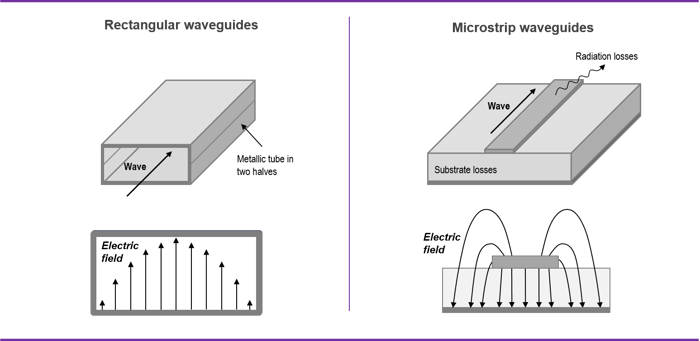Waveguides are the fundamental building block for constructing any microwave circuit or component, like an antenna. They act as electrical transmission lines for circuits operating at frequencies where the wavelength of the electromagnetic waves is of the same order as the circuit itself. As the frequency increases the wavelength shrinks, to just a couple of millimeters at 30 GHz.
Two classes of waveguides are normally used:
- Rectangular (or hollow core) waveguides
- Microstrip based waveguides
 Illustration of Rectangular waveguides and Microstrip waveguides
Illustration of Rectangular waveguides and Microstrip waveguides
Rectangular waveguides
In rectangular waveguides, the wave propagates in a metallic tube filled with air resulting in low losses. However, they require a very precise machining and assembly process as the tube needs to be manufactured in two halves and assembled with a perfect metallic contact to prevent the field from leaking out. Obtaining perfect metal contact requires either many screws (which is impractical), welding, or metal fusion of the two layers under high pressure and temperature. Rectangular waveguides have therefore mostly been used in military applications where cost is not as an important factor and volumes are lower.
Microstrip waveguides
Microstrip based waveguides on the other hand are much easier to produce as the waveguide is formed using copper traces on a printed circuit board (PCB). The wave propagation occurs within the substrate between the metal traces and the ground plane. However, as the propagation no longer occurs in air, losses increase dramatically above 20 GHz. Also, as some of the field extends out into the surrounding air the microstrip waveguide radiates, resulting in unwanted leakage and interference.


Opinions